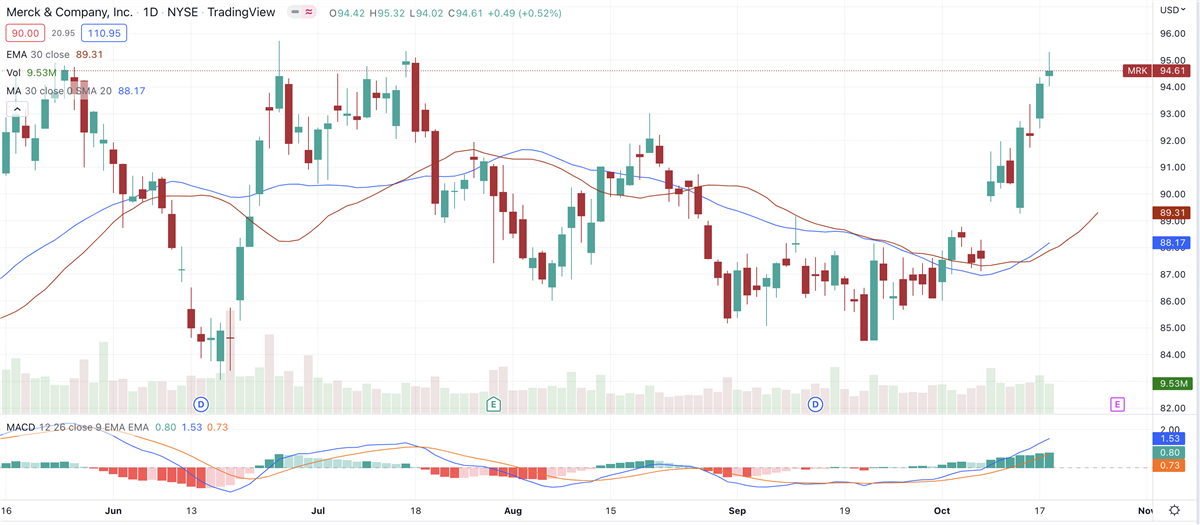 Dow component Merck (NYSE: MRK) is within 2% of a new all-time high, after rallying 7.30% in the past month. Shares closed Tuesday at $94.61, up $0.49, or 0.52% in volume that was 13% heavier than normal.
Dow component Merck (NYSE: MRK) is within 2% of a new all-time high, after rallying 7.30% in the past month. Shares closed Tuesday at $94.61, up $0.49, or 0.52% in volume that was 13% heavier than normal.Dow components are weighted according to price, which differs from the S&P 500’s market-cap weightings. As such, Merck is currently No. 24 among the Dow 30. The index advanced 1.12% Tuesday, or 337.98 points, in volume 2% lower than average.
Other healthcare stocks in the Dow include Johnson & Johnson (NYSE: JNJ), UnitedHealth (NYSE: UNH) and Amgen (NYSE: AMGN).
Merck’s recent rise follows a couple of positive developments in October. First, its $11.5 billion acquisition of Acceleron Pharma, completed in November 2021, yielded a win as Acceleron’s sotatercept, resulted in improvements for patients who took it with other high-blood-pressure treatments.
In the October 10 news release, Dr. Dean Y. Li, president of Merck Research Laboratories, said the company believed the study suggests that sotatercept has the potential to transform the treatment of patients with pulmonary arterial hypertension.
“We are moving with urgency on our regulatory applications to bring this investigational therapy to these patients,” Li said.
After those results were reported, Merck shares gapped 3.29% higher on October 10 and closed 2.8% above the 50-day moving average.
Merck ended last week with a gain of 5.23%.
To quote the late infomercial king Ron Popeil, “But wait, there’s more.” Merck had another piece of good news
On October 12, Merck announced a partnership with Moderna (NASDAQ: MRNA) to develop and commercialize a personalized cancer vaccine technology. Merck paid Moderna a $250 million licensing fee. The two companies plan to test the new vaccine along with Merck’s Keytruda therapy on skin-cancer patients.
Merck has defied the year-to-date decline that many other stocks have suffered. It boasts a 2022 return of 25.51% and is up 23.68% on a one-year basis.
MarketBeat analyst data reveal a “moderate buy” rating on Merck, with a price target of $99.83, representing a potential upside of 5.52%.
Since the October 10 announcement about sotatercept, four analysts either upgraded the stock or boosted their price targets. Only one, Morgan Stanley, lowered its price target, but only by $1, from $92 to $91. Morgan Stanley maintains an “equal weight” rating on the stock.
There’s one more potential catalyst ahead that could lead to a price move. Merck reports its third quarter on October 27, with Wall Street eyeing earnings of $1.68 per share on revenue of $14.28 billion.
Those would mark a year-over-year decrease of 4% on the bottom line and an increase of 8% on the top line.
According to earnings results compiled by MarketBeat, Merck beat net income and revenue expectations in each of the past four quarters.
Revenue grew at rates between 20% and 50% during that time. Earnings increased between 28% and 84%.
Merck is currently the best technical performer within the pharmaceuticals sub-industry in the healthcare sector.
Bristol-Myers Squibb (NYSE: BMY) and AbbVie (NYSE: ABBV) have also been better-than-average performers recently, although both are still forming steeper corrections while Merck is approaching a breakout.
Merck has formed a series of consolidations without undercutting prior structure lows, going back to early 2021. Since then, it’s notched five distinct bases without gaining 20% from any breakout. In a choppy market, it’s actually somewhat remarkable that the stock has managed to traverse higher in this fashion, without re-setting its base count by falling below a previous structure low. 
As always, use caution in a volatile market. A stock with strong technicals can be pulled sharply lower for essentially no reason, other than broad-market weakness.
So far in October, Merck’s upside trading volume is higher than average for this point in the month, but that could change. It hasn’t been unusual to see stocks break out of a base, and then see the breakout break down because the market can’t withstand a rally.






